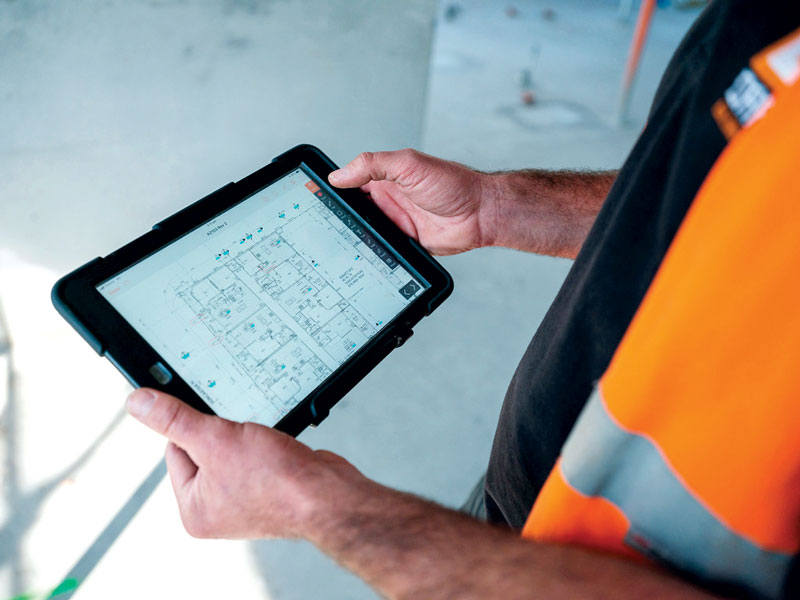
Between the labour shortage and the Covid-19 pandemic, communication has become a key focus within the construction industry.
“One of the most pressing issues in construction is field-to-office communications,” said Jas Saraw, vice president of Procore Canada. Procore is a construction management platform that enables critical communications between project team members and helps generate efficiencies in field-to-office communications without losing analytical oversight.
“When I first started in construction technology five years ago,” he said, “I had a lot of resistance from contractors who would swear by their pen and book to run their business. I don’t get that objection anymore.” Saraw says early adopters now centre their conversations around data and insights. “It’s really remarkable to have these discussions about harnessing the power of data to make data-driven decisions in a business,” he said. “It’s not just large enterprise businesses either, but smaller to medium businesses that are thinking and talking the same way.”
Procore’s expertise lies within its ability to manage communication, information and cost all in one space. The platform allows for a unified data model to solve project issues on the jobsite in real-time and provides reporting and analytics to help field and executive teams make meaningful decisions around how they should construct and build in the future.
Ultimately Saraw says, Procore wants to simplify what has historically been a very complex process within the construction industry.
“The technology lets users not only manage things like normal project management tasks you would expect to happen on the jobsite,” said Saraw, “but also allows for a deeper transparency concerning financial impacts that arise as a result of the decisions that happen on the jobsite.” Saraw says financial cost management is a massive issue on jobsites. “A good example would be communication between a contractor and a subcontractor that results in a change-order, which must be tracked and approved,” he said. “A variety of different people – such as stakeholders and accountants – require notice and the ability to track those changes financially. Not to mention, ensuring quality and safety due diligence to execute those changes.”
Ultimately Saraw says, Procore wants to simplify what has historically been a very complex process within the construction industry.
“If you think about how construction works, before technological management software, it was a project manager onsite with a pencil and paper trying to translate what they discovered on the field into cost information,” he said. “Then they either, through the course of a phone call or a team meeting back at [headquarters], bring that information to the accountant and upload it into the financial system.”

Procore fundamentally shifts that dialogue and puts the power of that data into the hands of the field teams, he says. Unlike other construction management software on the market, Procore aligns with the actual way construction gets done on the jobsite – from pre-construction to financial close – including all the necessary data and insights collected throughout.
“Procore possesses the capabilities an owner needs to manage their business,” said Saraw. “What we realized many years ago, if we did not provide the industry with a tool that was easy to use, there would be no way it would get adopted and used in any meaningful way by professionals on the jobsite.”
Saraw says construction jobs are already super challenging, dealing with high-stress situations where safety is a massive issue and being on time and on budget are critical. “There’s no time to force them to learn a complex technology – it’s not feasible,” he said. “So, what Procore does is mimic the workflows in construction and limits the number of keystrokes that they need to go through.”
Procore’s expertise lies within its ability to manage communication, information and cost all in one space.
Construction management software is only the beginning, though. Saraw says at Procore they have already advanced to include things such as platform integrations like DocuSign for electronic signatures. They want to continue to provide a smarter, more connected platform for their users. “We want to provide deeper insights and data for our clients in a much more rapid fashion than what we see today,” he said.
The acquisition of Levelset in September 2021, will add lien rights management to the platform, enabling Procore to manage complex compliance workflows and improve the payment process in construction. “Levelset effectively manages the complexity and compliance needs of managing payment in the industry between different stakeholders,” he said.
In October 2021, Procore acquired LaborChart, a provider of workforce management software for specialty contractors and self-performing general contractors. It deepens the office and field connection by empowering contractors to schedule, manage, forecast and communicate with their workforces, ultimately improving profit margins.

The construction industry has made strides towards adopting technology to help standardize processes, build transparency and save money. Yet, responding to the increasing labour shortage may require a more holistic way of using technology on the jobsite.
“There is a big push to find skilled trades,” said Saraw. “In the absence of people who can work on a jobsite, being able to effectively manage where you deploy your workforce and how you deploy your resources will make a big difference over time.” Saraw says Procore has also moved into artificial intelligence (AI) and machine learning (ML) with the acquisitions of INDUS.AI and Avata Intelligence earlier in 2021. “We want to provide deeper insights and data for our clients in a much more rapid fashion than what we see today,” he said.
For example, he says, an engineer looking at a drawing or photo can quickly determine through AI and ML patterns what areas of risk need communicating to a project manager or project executive on a jobsite. “The ability to predict patterns from AI and ML, the ability to identify risks early and confidently communicate that to the team,” said Saraw, “to me, that’s the difference between winning and losing on a jobsite.
“A lot of what you can achieve for your business, you can do through modern technology that fits right in your back pocket.”